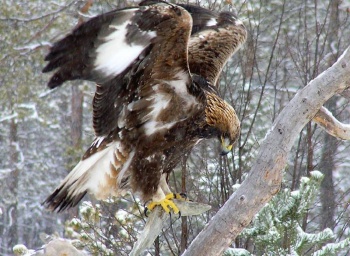m |
m (→External Links) |
||
| Line 21: | Line 21: | ||
==External Links== | ==External Links== | ||
*[http://www.birdforum.net/pp_gallery/showgallery.php?si=Aquila+chrysaetos+&perpage=12&sort=1&cat=all&ppuser=&[email protected]&password=&x=5&y=10 View more images of Golden Eagle in the gallery] | *[http://www.birdforum.net/pp_gallery/showgallery.php?si=Aquila+chrysaetos+&perpage=12&sort=1&cat=all&ppuser=&[email protected]&password=&x=5&y=10 View more images of Golden Eagle in the gallery] | ||
| + | *[http://www.goldeneagle.ie/index.html Golden Eagle Reintroduction Project] | ||
[[Category:Birds]] | [[Category:Birds]] | ||
Revision as of 06:52, 7 June 2007
- Aquila chrysaetos
Description
Location: Dalarna, Sweden
Identification
Golden Eagle Aquila chrysaetos RANGE North America, Europe, northern Asia and North Africa. The most numerous and widespread Aquila eagle.
In North America breeds over most of Alaska and in Canada except south-central and south-eastern parts. In the USA found in hilly and mountainous areas throughout the west and south to Calfornia and north and central Mexico. May also breed in very small numbers in the northern Appalachians. In winter occurs from southern Canada south to Mexico and in small numbers in the eastern USA but rare as far as Florida. In Europe breeds in north and west Scotland, most of Norway, north Sweden, Gotland and central Finland. To the east breeds in northern Poland, Estonia, Belarus and north Ukraine, and in western and Arctic Russia. Further south breeds in parts of southern France, on Corsica, Sardinia and Sicily, in the Alps and Apennines, in the Carpathians and at scattered sites throughout the Balkans. Widespread in Spain (but nearly extinct in Portugal), in the mountains of Morocco, Algeria and Tunisia, very small numbers in Sinai and Israel, Crete and across much of Turkey and the Caucasus.
The first breeding record for Jordan was in 1990 and in Denmark in 1999. Very small numbers are now breeding or at least attempting to do so in south-west Scotland and northern England. For more than thirty years there has been a breeding pair at Haweswater in the Lake District of England and in recent years the RSPB has run an observation centre from a safe distance. Access to the valley is prohibited but good views are possible with a telescope in clear weather.
Asian range extends from the Urals east to the Pacific coast of the Russian Far East , China, Korea and Japan. Northernmost birds, particularly juveniles move southwards in winter. Wanderers from the north of Scandinavia are seen annually in Denmark but rarely further south and occasional birds seen at Gibraltar and the Bosphorus. In the east a vagrant to south-east China.
HABITAT Mainly mountainous and hilly country but also in lowlands where not persecuted, semi-desert, desert and open plains in some parts of range. Hunts over forest edge and areas of open grassland or heather. Nests on cliff faces or in large trees.
SUBSPECIES Five races recognised: canadensis in north-east Siberia and North America, chrysaetos in Europe and western Asia, smaller and darker homeyeri in Iberia and north-west Africa, daphanea in Central Asia and japonica in Korea and Japan.
Bird Song
<flashmp3>Aquila chrysaetos (song).mp3</flashmp3>
Listen in an external program




